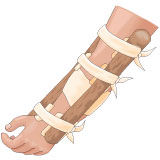First Aid: Falls and Broken Bones
Falls
You’re always at risk of falling when you hunt from a tree stand. Make plans for a worst-case scenario. Establish a signal that will let your companions know if you fall. Three blasts on a whistle carry farther than a human voice, and it’s a recognized call for help.
If you are hunting alone, what you do depends on your injuries.
- If your injuries are immobilizing, you’ll be forced to wait and use your signal until you’re found. This is a time when a hunting plan may literally save your life.
- If you can move, consider your location and how close you are to assistance. Are you mobile enough to make it to help?
- If you have broken bones, sprains, or cuts, use what you have available for first aid.
- Clothing and large handkerchiefs can be used to stop bleeding and provide padding.
- Use belts, shoelaces, bowstrings, or haul lines to secure splints.
- Your bow, arrows (without points), branches, or poles can provide rigid support of broken bones or sprained limbs.
- Know how to use a rope or strap to relieve suspension trauma when hanging from a fall-arrest system.
- Take a first-aid course to learn how to effectively treat a victim of suspension trauma.
Broken Bones
Don’t move someone with a back or neck injury. That should be left to paramedics or other professionals because permanent damage could result from improper handling. When a hunter has a broken leg, foot, arm, or hand, you can perform basic first aid that will allow the individual to be transported to a medical facility.
- Keep broken bones stable by immobilizing them with splints. Any stiff material can be used—a bow; sticks; boards; tree limbs; arrows with the points removed; or even books, newspapers, or thick magazines.
- Use a belt, rope, or strips of torn clothing to bind the splints and broken bones together. But don’t tie them so tightly that you cut off circulation.
- Move the victim carefully and only as much as necessary to reach professional medical help.
